Batman: Arkham City Review
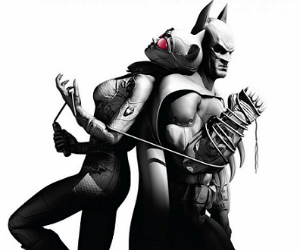 Game: Batman: Arkham City
Game: Batman: Arkham City
Developer: Rocksteady Studios
Publisher: Warner Bros. Interactive Entertainment
Available on: PlayStation 3, Xbox 360, PC, OnLive (Reviewed on Xbox 360)
Harvey Dent is right. Like a coin, life has only two sides. Black or white. Right or wrong. Stick to the familiar, dare to be different.
The defaced coin is thrown skyward, spinning in the air.
Rocksteady created an instant classic with Batman: Arkham Asylum, a bruising, Metroid-style tribute to Grant Morrison’s dense, symbolic graphic novel.
Arkham City was the British developer’s chance to cash in, to empty the Dark Knight’s utility belt and give us the same adventure with a different back-drop, new setting and new villains. There would be no shame in it; Zelda recycles the same tropes and patterns every few years, telling the same broad tale to the delight of fans across the world.
The coin is dropping. Inevitable. Fair.
Perhaps they could take their creation, a game that remains underrated even with a Metacritic score in the low nineties, and take it to pieces. Keeping only what makes the game a Batman experience. Brutal, rhythmic, dominating combat remains. Stealth is enhanced. The characters, distorted and exaggerated to the edge of recognition, persist. But the bricks and mortar of the structure are torn down, Metroid-style levels replaced by a largely open world. The new Batman can choose; fight or remain in the shadows? Stalk the streets or hunt from the rooftops. The game looks the same, but fundamentally, it is different.
The coin lands. Clean side up, the glowing face of lady liberty. Safety.
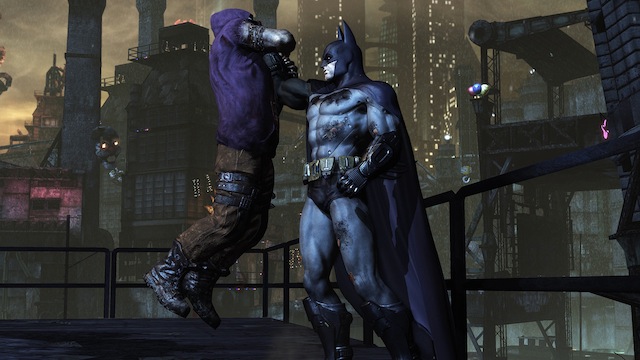
Rocksteady opted for the latter, to their eternal credit, they decided that they could do more with Batman’s world, and they have attempted to deliver. In a world governed by profit margin, marketing only what is familiar and bolting features onto an otherwise carbon copy of the original, Rocksteady have taken The Bat in a new direction and tried to enhance the incredible Arkham Asylum concept in every conceivable way.
But Harvey Dent isn’t right. He never was. Madness distorts. The world isn’t black and white. It is full of grey. Rocksteady opted for the noble route, challenged not only themselves as a developer but also the willingness of gamers to adjust and embrace change. Utterly commendable, the RIGHT thing to do?
But has it made the game better? Is change, however admirable it may be, always for the good?
Heads or Tails. Yes or no. Better or Worse. The coin is still spinning.
This game is available for a 30 minute demo via OnLive, by clicking the banner below:
STORY: One of the great strengths of Arkham City is how dense it is. The sheer volume of of content, the constant radio chatter, the side missions and, glaringly, the amount of villains that Batman has to beat down.
Marquee names like Joker and Two Face loom large, but writer Paul Dini wasn’t afraid to promote some of Batman’s less well known foes to top billing. Aficionados will be aware of Hugo Strange and Talia Al-Ghul, but for many this will be a first foray into lower echelons of the Dark Knight’s rogue gallery. Irrespective of Batman knowledge, it is going to be a treat; all the enemies are gripping screen stealers, stylishly supported by environment design that really enhances character and narrative. Walking through Two-Face’s courtroom, one half of the building immaculately kept whilst the other rots into oblivion, vividly illustrates the ex-District Attorney’s horrible madness.
In this way Arkham City is a classic Batman tale. With few exceptions, the best Batman stories draw on a variety of enemies to keep the pace, conflict and variety, high. Books like Hush, The Dark Knight Returns and Arkham Asylum are peppered with ne’er do wells, all reflecting parts of The Bat back onto himself, casting the shadows of his past and obsessions across the Caped Crusader.
If the Batman Arkham City story does fall down, then it is here.
Batman games, like Gran Turismo and Football Manager, are wish fulfilment games. Bruce Wayne is a character who players want to inhabit. We want to be The Bat, with all the trimmings. That means seeing the character as the ying to Joker’s yang, to see Mr Freeze’s obsession with his wife mirrored in Batman’s obsession with fighting crime, Riddler’s existence being as much because of Batman as despite him. The game’s run of villains, particularly those demoted to side-quest status, represent little more than a star tour, with only a few truly deep characters to create the psychological tug-and-pull that makes the great Batman stories rise above almost any other superhero story.
That said, for relatively one-dimensional foes, the action encounters can be thrilling. Batman’s sneering disgust at the Penguin, a low-life, east-end thug in the hands of Rocksteady’s imaginative sculptors, is like something from a Clint Eastwood film, top lip curled and boot raised ready to stamp Cobblepot into the ground as soon as gets his hands on him. This character interplay varies across the game but is always entertaining, without ever reaching into the depths of theme and character that have made the Batman films and graphic novels such shining examples of the genre.
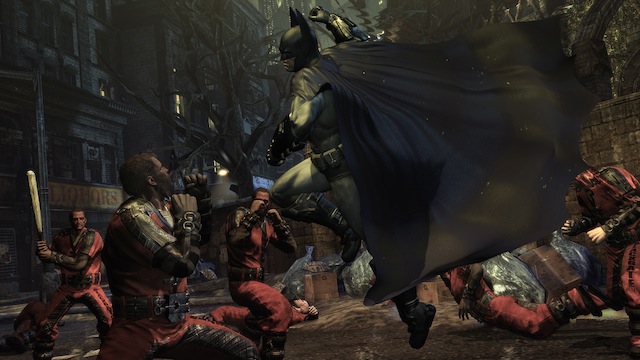
Arkham City crams in plenty of narrative content, with a punchy main quest that is substantial without ever becoming overly long or pedestrian. What is important is that Batman is always detecting, always searching for enemies and always doing the things that Batman should be doing. All that in a city which, in the great tradition of game writing cliches, is a character all of its own.
It might not be the best Batman story of all time and, for some, it may be less of a story than the first of Rocksteady’s Batman game because, as will be discussed, there is so much more here to distract the player from the pure, cinematic story at the core of Arkham City experience.
GRAPHICS: Whether perched high on one of the gargoyles that watch over the city, or skulking through the underground levels filled with villainy, Rocksteady deliver when it comes to the visuals of Arkham City. The scale is grand and the vision broad, but the team never forgets to maximise every sight line, always giving the player something to catch their eye.
But it is not the stunning views that are the gem of the Batman graphical package. It is the close up, the bane of videogame graphics, that really star here. Far from the dead eyes and flat textures we have come to expect, here you can see Joker’s features dance madly, as Batman’s scowl creases viscerally under the black rubber of that famous hood. This execution of both near and far shots lets the cutscene directors create a bold, kinetic quality in the cinematics, camera diving in and out with the speed and precision of a Catwoman combo. Stellar stuff.
Despite the visuals being instantly familiar, Arkham City feels like a marked improvement over its predecessor in almost every way. Everything you remember is there: Batman’s disintegrating suit, the teflon-smooth animation flitting from punch to punch and the in-jokes and references that cover the walls. However, there is so much more. Each major villain has his or her gang, or dressed in slavish reverence of their master. Joker’s face painted goons return, whilst Dent’s disfigured followers and Penguin’s balaclava clad followers also stalk the Gotham skyline. They morph as the city does, subtly mixing across the different districts until you are surrounded by the neon and brightly coloured Joker lair of the steel works or the imposing architecture around Penguin’s iceberg lounge.
Beyond simply looking great, the designers and artists at Rocksteady have thought hard about the original game’s most controversial feature: Detective Mode. It is no secret that, in Arkham Asylum, there was little downside to playing almost the entire game in Detective Mode. However, it did undermine all the hard work the texture artists put in, as everything became covered in a blue-tinged wireframe. Detective Mode Returns in Arkham City but with restrictions. Navigating the vast city is tough, so Batman is provided with a compass and navigation bar at the top of the screen unless Detective Mode is activated, in which case the bar disappears. This simple mechanism keeps the player out of Detective Mode when traversing environments, rewarding the texture artists for their hardwork and letting the player enjoy the visual spectacle all the more.
SOUND: Denser than mercury bath water, Arkham City’s audio is the anchor that keeps you deeply immersed in the world. Gangs chatter to each other, political prisoners hide in back alleys and bemoan their plight and the rogues gallery chip in to keep Batman’s world constantly alive and permanently interacting with the player. The texture of the world, of Strange’s sprawling mega-prison in the heart of Gotham, is rendered so thick and full that, at any time, it feels as if you can grab it by the hair and rub your face in it.
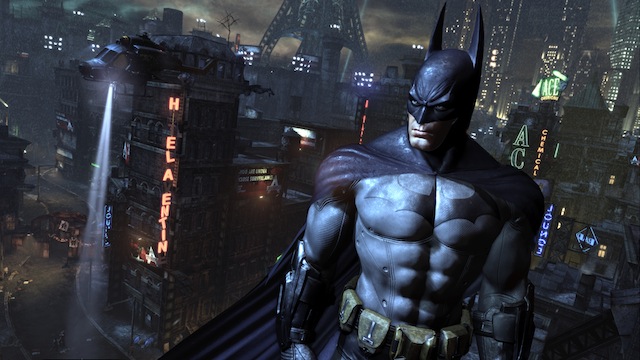
Surround sound is stunningly accurate but, in much the same way as the visuals, the audio is best when characters are filling the screen, the brilliant voice actors doing their thing. Hamill returns and appears to have utterly nailed his turn as the Joker, the deranged ringmaster of his own violent circus. Kevin Conroy as Batman is grizzly, angry and intense, and Nolan North, videogame voice-over’s favourite son, continues his chameleon act with his east-end gangster turn as the penguin.
The vocals are every bit as good as the visuals, which is about as higher praise as can be offered.
GAMEPLAY: Here is where Rocksteady have made the most changes. Structurally, Batman: Arkham Asylum was pure Metroid, a linear path that had Batman doubling back on himself and opening new areas as he accrued new tools. Arkham City, at first glance, is an open world structure. The outer city, from the first minute of the game, is available for Batman and the player to explore. It is somewhat a mirage, however, as the antagonists hideouts are hidden behind barriers that need certain tools to crack. This means that the main story line is almost entirely a linear experience, at odds with the freeform invitation the world appears to offer.
This switch does change the tempo of the game and, player by player, this is going to change how they view the franchise. Arkham Asylum was tight and linear, the Joker always on top of you and always pushing you forward. Riddler trophies were easier to collect, just a function of using the right tool when it became available, and the whole game flowed forward fast and fluently, like a new river at the top of a mountain, dragging the player through the tale. Arkham City feels like a river further downstream, slower, more winding with more time to stop and take in the scenery. Not worse, but not necessarily better, and certainly very different. At times, when collecting one of the four hundred Riddler trophies dotted around the landscape, it can feel as if the story has melted into the background and that Batman’s battle is against only the Riddler, the tensions of the main quest lost amongst the search for hidden items; hidden items that are far from optional. There is a huge amount of scope to level up and upgrade Batman, despite him carrying most of his moves from Arkham Asylum into this new title. Levelling up to maximum does require a large degree of trophy collection, with huge experience points on offer for the completion of one of Riddler’s challenges, and players looking to access every skill will find themselves wandering off the main path more than once in the hunt for more experience points.
These extra skills bring another new aspect into the game; an increasingly complex control system which, after a few hours of upgrading begins to reach Metal Gear Solid levels of dexterity to fully master. It is a fascinating trade off. Rocksteady, so determined to throw out the rule book on what a sequel should be, shirked the cliché of removing a character’s traits learned in the previous game. It makes Batman, from minute one, an absolute powerhouse, able to punish enemies with a baffling array of tricks. Freeflow combat, the perfect partner to one of the world’s premier martial artists and the shining example of game system married perfectly to game character, returns in full force and the player has never felt more like Batman. That is until they mistakenly fire a batarang in combat, instead of explosives, or activate the wrong move because the ability they were looking for was lost under a pile of other similar techniques accessed through similar thumb motions. The moment passes, the combo ends, and the immersion of the game is broken, however fleetingly, in way that just wasn’t the case in the first game.
Movement around the city rarely suffers from this issue. It takes seconds to master the basic glide moves that allow Batman to traverse huge expanses of Arkham City in seconds, making him far more agile than the Batman of the first game. The controls are simple but, as the flight tutorial sections show, there is a depth and subtly that makes mastering all of Batman’s movements tricky.
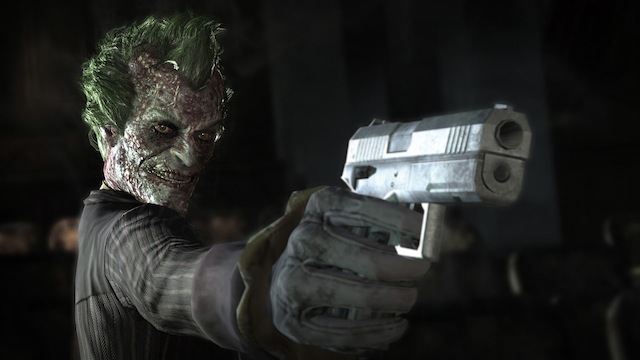
The Bat isn’t the only one who has learnt some new skills, even the run of the mill goons have learnt some new tricks. Heat vision goggles and radio jamming backpacks are just a couple of the new moves that the gangs have to keep you working hard. They are well designed too, the heat goggles that keep Batman out of the rafters and force him to move around stealthily on the dangerous ground level, really mix things up and force players to use a variety of strategies to clean out a room.
Whilst it is right to praise Rocksteady for trying to buck as many trends as possible, it is not as easy to say that, unequivocally, this is a better game. There is certainly more to do, much more, but the slightly random nature of the Riddler puzzles and a couple of limp side quests means that more doesn’t necessarily mean better.
LONGEVITY: If it wasn’t mentioned before, then it bears repeating. Batman: Arkham City is crammed full of content. Although, and this has been said before as well, Rocksteady are not afraid to buck a trend and the longevity in Arkham City will not come from multiplayer; this is a story driven game, that focusses on tight bursts of action and stealth to drive the player into the next room.
Riddler puzzles, side quests, challenge rooms, unlockables; getting every piece of the Batman puzzle is going to take a very long time. Arkham City is a visually interesting, exciting place to be and spending more time there can only be a good thing. This is especially true because most of the side quests, while nothing more than orienteering in many cases, are beautifully dressed as activities befitting the Batman. To spoil them here would be to ruin much of the surprise Arkham City has to offer but, needless to say, there are plenty of hours to be spent skirting over rooftops and examining crime scenes if the player just wants to get lost in the city.
Not all the puzzles and side quests are up to the same standard, however. Riddler Trophies are often hidden by pressure pad puzzles which are hardly befitting the Bat’s talents and serve only to slow the game down and distract from the more interesting fare.
Despite a little bit of clutter, the amount of love, fan service and the sheer wealth of content easily overwhelms anyone inconsiderate enough to ask why the game has no multiplayer. Fans of Batman will be hunting in Arkham City for a very long time.
VERDICT: So as the coin finally falls, what has been learnt about Batman Arkham City?
Rocksteady have polished the technical aspects of the game until they shine like the Bat-Signal, with audio and graphics being stunning beacons of quality.
When they couldn’t polish they changed. They pushed boundaries and bucked trends and created a bigger, bolder Batman. It is totally commendable.
But the world isn’t black and white, bigger isn’t always better and not every change can bring a benefit. Rocksteady did the right thing by challenging themselves and the player, asking them to embrace something new.But they have altered the fundamental structure of the game, left a successful formula behind, and everything feels different.
Arkham City is a stunning, ambitious game, one that truly does justice to Batman and the franchise, but for some players the departure from the first game’s linear, taut style will be too much to bear. For others, the freedom to be The Bat is everything they ever asked for. Either way, the game is a towering achievement.






